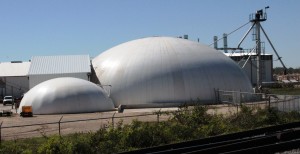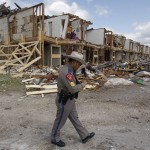Would Igloos Lower Risk of Fertilizer Explosions?

Dave Fehling / StateImpact
Domes at fertilizer facility near Bryan where fire in 2009 destroyed a wooden structure
In response to the deadly explosion six months ago in West, Federal agencies will soon be making recommendations to Congress on how to reduce the risk at fertilizer storage facilities. Should igloos be among the ideas?
“There’s no doubt whatsoever in my mind that if the West (fertilizer) had been in a dome it would have lost the top, you would have heard a lot of noise, but it would not have damaged the buildings around it,” said David South, president of Monolithic, a company in Italy, Texas that designs concrete dome structures.

Dave Fehling / StateImpact
David South's company designs concrete domes
Blowing Up, Not Out
The idea that domes are good buildings for bad situations was highlighted when the Federal Emergency Management Agency (FEMA) began awarding grants to build domes to protect people in hurricane-prone areas of Texas.
But when the threat comes not from wind on the outside but rather from a potential explosion on the inside, South said domes are uniquely suited to the job.
“If it does get exploded, it’ll blow the top off and vent the pressure up instead of out to the side,” South told StateImpact.
South pointed to photos posted on the company’s website showing a grain explosion that blew a dome’s top off. Another photo shows how a fire that erupted outside a dome scorched the dome’s exterior shell but, according to South, didn’t harm the fertilizer stored inside.
Anything But Wood
One of the nation’s leading experts on chemical safety said he could not assess what difference a dome structure might make if an explosion occurred but said almost any building made of concrete would be a huge improvement over wooden buildings commonly used for fertilizer storage.

Dave Fehling / StateImpact
Sam Mannan is a chemical safety researcher at Texas A&M
“From what I’ve heard, it’s not uncommon to have a wood structure. And that really scares me that we still have facilities storing ammonia nitrate in wood structures,” said Sam Mannan, director of Texas A&M’s Mary Kay O’Connor Process Safety Center.
Mannan had testified before the U.S. Senate committee investigating the West explosion and in an interview with StateImpact, explained that while ammonia nitrate fertilizer isn’t explosive on its own, it can become explosive if it comes in contact with organic matter like wood.
A preliminary report on the West explosion noted that “wooden buildings are still the norm” for storing ammonia nitrate fertilizer. The report by the U.S. Chemical Safety Board said current national fire standards allow for wooden buildings and bins. In September, federal regulators put out an advisory recommending against the use of wooden storage structures.
A Fire Leads to Change in Bryan

Dave Fehling / StateImpact
Chuck Frazier is Brazos County's head of emergency management
Some fertilizer distributors have been using fire-resistant concrete structures for years. Just outside the city of Bryan, a fertilizer fire in 2009 at the El Dorado Chemical Company prompted local officials to warn some 70,000 residents to evacuate. The fire burned itself out and there was no explosion. But when the company rebuilt the storage facility, it replaced the wooden building destroyed by the fire with a concrete dome.
“The need for the facilities is there. You have the agriculture industry, you have to have access to the product for the farmers,” said Chuck Frazier, Emergency Management Coordinator for Brazos County.
“The facilities aren’t going away and the people aren’t going away so you just have to figure out how to coexist.”
